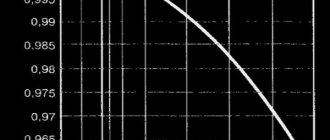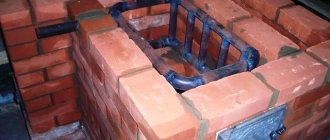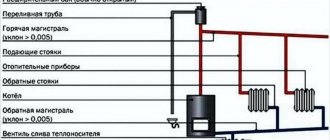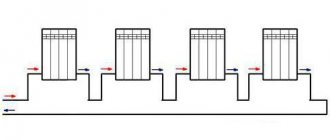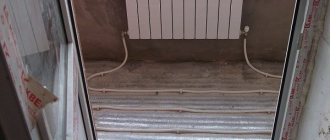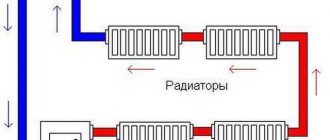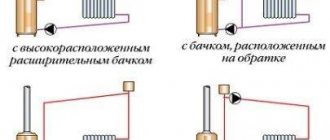All issues of organizing autonomous heat supply and hot water preparation are resolved by purchasing one boiler capable of servicing both systems. Without knowing the operating principle of a double-circuit gas heating boiler, it would be illogical not only to make a purchase, but also to operate the unit. Do you agree?
We will tell you about the operation scheme of the heating device, consider all its strengths and weaknesses. By understanding the basic operation of the equipment, you can easily take advantage of all its benefits. And if necessary, it will be possible to identify operational failures in a timely manner, understand and eliminate the causes of their origin.
Boiler design for servicing two circuits
A double-circuit gas heat generator differs from a single-circuit analogue in that instead of one heat exchanger, it has two, which in technical terminology are called primary and secondary.
The first one, i.e. The primary heat exchanger is located directly in the flame combustion zone. Its task is to heat the coolant for the functioning of the heating network. The secondary heat exchanger is responsible for the operation of the hot water supply.
Stable operation of the heating device is possible with coordinated operation of all its components. Information about the main functional units will help you understand the operating principle of the equipment
The design of any two-circuit unit includes the following standard elements:
- Combustion chamber with burner block;
- Heat exchangers;
- Equipment control and protection devices.
To understand the design features of double-circuit gas boilers, we will dwell in detail on each of its structural elements.
Types of gas burners for double-circuit boilers
The burner of a gas boiler is responsible for obtaining a sufficient amount of heat necessary for the functioning of the heating and hot water supply circuit. Thermal energy is obtained by burning fuel. Place the burner in the combustion chamber, into which air is pumped in addition to gas. It is needed for the combustion process.
Depending on the operating modes, burners can be classified into the following types:
- Single level burner . A unit with such a burner can operate in only two modes - “Stop” and “Start”. Such boilers, despite their low efficiency and reduced service life, are popular due to their simplicity of design and low cost.
- Two-level burner . A heater with such a burner can operate at full or half power. Its advantages are noticeable in the warm season, when there is no need to operate the device at full power to heat water that is not too cold.
- Modulating burner . A smart boiler system with a similar burner allows you to configure and regulate power. Such a boiler is characterized by a high service life and efficiency, but at the same time it costs an order of magnitude higher than units with single-level and two-level burners.
Burners are divided into open and closed designs. When the burner is open, the air required to burn the fuel comes directly from the room in which the boiler is located. To remove combustion products, a chimney is required, which must provide sufficient natural draft.
Atmospheric heating units are usually equipped with a regular metal pipe, while turbine units are equipped with a coaxial chimney. Depending on the technical conditions of the room, the smoke duct is placed vertically or built at an angle. Corner options lead through the wall to the street or connect to a public chimney shaft.
The gas burner is the main element of a double-circuit gas boiler; it is responsible for burning fuel and obtaining thermal energy in the required quantity
Turbine boilers are equipped with closed combustion chambers into which air cannot flow spontaneously. They are safer and more reliable in operation, but more expensive and more difficult to operate. Boilers with closed burners, in addition to a smoke exhaust, require a channel through which the oxygen required for combustion is supplied to the chamber.
That’s why they equip turbine boilers with coaxial pipes, because in addition to removing smoke, they also draw in fresh air flow from the street. It happens that for normal operation, two coaxial chimneys are connected to a closed combustion chamber. In addition, the entire structure is supplemented with an air supply pipe.
All similar boiler models are equipped with fans that provide smoke movement, multi-level protection systems, and automation. The listed devices and systems require electricity to operate. Their disadvantage is their energy dependence, which increases operating costs.
Types of heat exchangers for gas units
If a burner burns fuel to produce heat, the heat exchanger provides this heat for further transfer to water. As already mentioned, the double-circuit design contains primary and secondary heat exchangers.
The primary heat exchanger is located directly above the burner and is a finned tube bent in the shape of a snake. Under the influence of the flame, the water in the heat exchanger heats up and moves through a three-way valve further into the heating system wiring.
The secondary heat exchanger is a system of wavy plates, which are assembled into a single block with two pairs of holes. Each pair of holes has its own functions.
Water from the water supply flows through one of the pairs, and the coolant flows through the second, entering the heating circuit. A similar system of plate and tubular heat exchangers is called dual.
The primary and secondary heat exchanger are combined into one system, the correct operation of which is ensured by a special three-way valve
There are heating devices that use a bithermic heat exchanger of complex configuration instead of a dual system. This heat exchanger is made of copper; it consists of a pair of tubes located one inside the other. Coolant flows through the outer tube, and water flows through the inner tube to ensure the operation of the hot water supply.
The bithermal heat exchanger of the coolant and water heater has a complex configuration, when the tube of one circuit is placed in the tube of another circuit
Boilers with a bithermal heat exchanger are more difficult to operate, since both heat exchangers are represented by a single unit, which makes it difficult to descale. But such heating devices are in demand, as they are characterized by small overall dimensions and high water heating speed.
Automation or boiler control unit
The boiler automation is responsible for safe and stable operation. It monitors the water temperature in the DHW components and maintains the temperature of the coolant in the heating lines. The automation of a gas boiler does not allow the heating device to operate in the event of dangerous situations.
The unit interrupts operation or does not turn on in the following cases:
- Reduced pressure in the gas system;
- Lack of traction;
- Absence or critical overheating of coolant.
The control unit, which controls the operation of protection and process automation devices, is represented by a set of switches, microcircuits, or a combination thereof. In addition to ensuring safety and temperature control, it monitors the operation of the circulation pump and fan.
Modern gas boilers are distinguished by the presence of intelligent controls, the software of which contains various operating modes.
What to do if the house is huge in area
- For a huge two-story building with a significant number of separate rooms, a two-pipe heating scheme is best suited. It must have a top spill and permanent radiator wiring.
- Directly from the heat generator, the heated water flows up the supply pipe. It goes around the building along its attic or along the ceiling of the upper floor.
- Then the water enters the risers, and batteries are connected to them. They do not completely open the riser. Any device is equipped with an adjusting throttle and a jumper.
- It is necessary to install a shut-off valve on the second branch of the supply pipeline. It is possible to install only one valve for bleeding air and screw it to the expansion tank in the upper section of the circuit.
- Through the second (lower) pipe, which goes around the building through the basement or floors of the first floor, water flows back into the boiler.
Note! Such piping of a double-circuit heating boiler has one important advantage. If necessary, it is able to function thanks to the natural circulation of the coolant. A pipe for water flow to the upper bottling section will act as an accelerating manifold.
In other words, a system with such a circuit can operate without electricity-dependent units (for example, a pump). Based on this, if force majeure events occur, you will not freeze under any circumstances.
Increasing the thermal inertia of the system
You have the opportunity to increase the thermal inertia of the heating system with your own hands.
- It is convenient to do this by choosing a slightly larger cross-section of contour pipes than required by the project.
- In addition, it is possible to replace aluminum batteries with cast iron counterparts. They have an expanded internal number of sections, which increases the thermal conductivity and heat capacity of the material. There is a conclusion that all cast iron radiators for heating systems have an ugly design. But, this is not true. Yes, their obsolete Soviet-era models are still being produced. But besides them, the market also offers modern analogues. For example, beautiful floor radiators made of wrought iron or wall-mounted radiators with flat, aesthetic shapes.
- Often the attic or second floor of a house is needed only occasionally in the winter, for example, to accommodate guests. Then a good option is to use a heating circuit with two heat generators and separate single-pipe circuits for each floor.
- In this case, the boiler at the top will be operated most of the time in economical mode, i.e. Maintain temperatures around +5 degrees.
The most inexpensive method to overcome all troubles
- It is also possible to independently improve the heating network, repeatedly increasing its thermal inertia.
- To do this, you need to add a thermal energy accumulator (storage tank) to the circuit. It is a container with a volume of 300/2000 l, which has two connecting pipes. The tank should be well insulated to reduce heat loss.
- The container helps to accumulate huge volumes of heated water. If the boiler stops, the heat reserve from this tank is wasted. It is clear that the larger the tank, the slower the radiators will cool.
- The heat accumulator can be installed on any part of the heating system. It is possible to mount it in the basement. To do this, you need to open the lower circuit with two pipes. It is possible to place the unit in a storage room. An interesting option is to transform the device into a hot bed base. Since it will inevitably release some heat into the atmosphere.
- The battery will compensate for temperature changes in the coolant while the boiler warms the water for domestic hot water. It is very beneficial if the boiler runs on electricity.
Note! It goes without saying that this method also has its disadvantages. For example, a heat accumulator is quite expensive. A high-quality insulated model with a quantity of one cubic meter will cost you 20/30 rubles, which depends on the manufacturing company.
Operating principle and specifics
Many owners of gas equipment do not even think about how a double-circuit gas boiler actually works. They mistakenly believe that heating of water and the heating circuit occurs simultaneously. In reality, things don't look so rosy.
A double-circuit gas boiler cannot operate in two modes simultaneously, ensuring the operation of heating and hot water systems. This is confirmed by the presence of a three-way valve in its device
In normal mode, the boiler constantly operates only to heat the coolant circulating in the system. In this case, the switching frequency and intensity of the flame are controlled by a temperature sensor. Simultaneously with the burner, the circulation pump is started if the operation of the heating system is not based on the natural circulation of the coolant.
The space in the lower part of the wall-mounted boiler is intended for gas supply, cold water connection, as well as outlets for the DHW system and heating circuit
Essentially, when the coolant temperature reaches a predetermined value, the sensor sends a signal to reduce burner activity. Until the temperature drops to the set value, the boiler will be in passive mode. Then again a command is received from the automatic sensor to activate the fuel supply valve.
Preparatory work
The pipe arrangement system and their number are calculated in advance.
The procedure for the troublesome installation of a double-circuit heating system usually begins with complex hydraulic calculations. There is practically no way to do this properly on your own. Therefore, it is recommended to turn to professionals: they can take into account all the nuances and features of the structure in which heating equipment needs to be installed. A correctly selected heating scheme for a private house with a gas double-circuit boiler will ensure a more economical use of heating resources in the future.
A competent calculation will help you choose the optimal structural solution for the construction, the number of components that will certainly be required to connect the heating system.
Scheme of operation of a double-circuit boiler
The presence of a hot water supply system slightly complicates the operation of a double-circuit gas boiler. The coolant heated by the burner, moving through the heat exchanger, ensures heating of the plate heat exchanger through which water from the water supply flows.
Design diagram of a double-circuit gas boiler with bithermal and two conventional heat exchangers. In the first option there is no need to use two heat exchangers
Simultaneous use of a dual-circuit model in heating and hot water supply mode is impossible. When the hot water tap is activated, the three-way thermostatic valve stops the circulation of coolant through the heating lines. The boiler switches to the mode of moving water along a circuit with a plate heat exchanger, which heats water for domestic needs.
If there is a significant consumption of hot water, the operation of the heating-oriented boiler may be paralyzed for a long time. The problem can be solved in two ways - to provide for the installation of a more powerful heating device or to include an indirect heating boiler in the arrangement.
If the hot water system is actively used, it is possible to install a double-circuit boiler with a built-in boiler. In this case, fuel consumption increases slightly due to the fact that during the pause between operating cycles of the heating system, the burner energy is used to maintain the water temperature in the additional gas water heater.
A certain supply of hot water in the built-in boiler allows you to use the DHW system without turning off the heating circuit. As a result, both systems operate alternately, without overheating the liquid and extending the life of the heat exchanger.
A boiler with a built-in standard boiler not only provides a sufficient reserve volume of hot water, but also helps to avoid long-term shutdowns of the heating circuit
The built-in standard boiler allows you to get hot water at the desired temperature at any time, the supply of which is provided automatically. While a flow-through DHW system takes several minutes to heat the water to the required temperature.
Heating arrangement if the building is small
Let's consider a possible wiring diagram for a double-circuit heating boiler if the house is one-story, small (up to 100 m2) and has a couple of separate rooms, all of which need to be heated.
In this case, a single-pipe network would be optimal. It is the simplest in design and installation; there are practically no troubles during its operation. Also, the price of the system will be low due to the savings in materials, since less materials will be required than for a two-pipe analogue.
Implementation of the scheme
- The small size of the building indicates that there will be few residents in it. This means that the consumption of warm water will be small. Here you should not abandon aluminum batteries that have poor inertia, but are excellent and give off heat well. Cast iron analogues are heat-intensive, but, in most cases, unaesthetic.
- In this case, it is recommended to expand the amount of coolant in the pipes. The optimal solution to the problem is to increase the cross-section of products by one row. For example, from Du-30 to Du-40. The amount of water in the circuits will then increase by 1.6 times.
- All radiators must be mounted, without opening the circuit, parallel to it. The pattern of their insertion may be diagonal or bottom.
The instructions recommend installing on each battery:
- throttle (feed balancing);
- return shut-off valve;
- a valve for bleeding air from the system (of a simple design or Mayevsky) into the right or left upper plug.
Option with bottom wiring
- In this case, there is no need to reduce the cross-section of the main circuit and open it.
- Immediately after the heat generator, the circuit pipe must be sharply raised vertically for the “acceleration” manifold. After this, it must be tilted (constantly) downwards.
Note! This type of pipe routing is quite complicated and unsightly. But it is needed so that when the pump is turned off, the heating batteries warm up due to natural circulation.
- Install an expansion tank (membrane) in front of the boiler (along the coolant flow). It will compensate for the increase in water volume when it is heated.
- The tank must have a capacity of 10 percent of the volume of the coolant. The reservoir should be placed with the eyeliner facing up.
Types of gas boilers with two circuits
The operating features of gas equipment are largely determined by the design version of the heating device. Modern boilers are available in two form factors - floor-mounted and wall-mounted.
When choosing a design option, you need to focus on the size of the heated area and the activity of using the hot water system. You need to understand that wall-mounted boilers are more compact, but at the same time they have much less power.
The double-circuit wall-mounted gas boiler has a compact size and modern design, but is only effective when heating small areas with moderate hot water consumption
The choice of a wall-mounted double-circuit boiler may be justified if the heated area does not exceed 200 sq.m, and the total productivity of the hot water system does not exceed 14 l/min.
The small size of a wall-mounted boiler, although it seems like an advantage, actually hides many disadvantages. Compactness is achieved through the use of thinner heat exchanger tubes. In addition to the fact that they have a shorter service life, there is a possibility of clogging.
In floor-standing installations, more massive and reliable cast iron heat exchangers are used. This not only increases the reliability of the heating device, but also extends its service life.
Advantages and disadvantages of dual-circuit devices
The advantages of a double-circuit heating unit are as follows:
- Economical fuel consumption. The direction for comparison is to use a double-circuit boiler or a single-circuit boiler with indirect heating.
- Compact sizes. The overwhelming majority of double-circuit boilers are wall-mounted heating devices. They are easy to place both in utility rooms and in small kitchens.
- Versatility. There is no need to buy additional equipment and resolve issues with its compatibility with the boiler.
In one unit, a flow-through water heater, a heating device and a circulation pump have already been successfully combined into a single automated system.
Obviously, along with the advantages, there are also disadvantages:
- Impossibility of simultaneous operation of the heating and DHW circuit. In this regard, significant consumption of hot water can cause a decrease in the temperature in the house.
- Power limitations of wall-mounted models. Compact wall-mounted boilers, due to the minimum size of the burner, are not able to provide the required temperature conditions at maximum pressure. A similar disadvantage is observed when water intake points are located remotely.
- Sensitivity to water quality. The secondary plate heat exchanger is demanding on the quality of the water consumed. The presence of impurities causes the use of means to reduce its hardness and clean the coolant.
Another criterion for evaluating a double-circuit boiler is its cost. The price of a double-circuit heater is higher than the price of a single-circuit analogue.
However, if we consider the presence of a hot water system and ways to resolve the issue in the case of installing a single-circuit boiler, then if indirect heating is included in the boiler assembly scheme, the price of a double-circuit boiler will be lower.
Types of double-circuit heating systems
Since there are many two-pipe heating systems in use, each of which has its own characteristics, it is worth understanding the basic circuits.
Horizontal and vertical
The heating design is selected based on the number of floors in the building.
The type of layout is determined based on the method of installation of the double-circuit heating system.
A vertical scheme is better suited for structures with several floors, a horizontal one - for one-story buildings of a huge area.
The installation of the first involves a number of separate risers and batteries. The other has one or two risers, as well as several heating sources located on the same level.
Bottom and top wiring
An important distinctive feature is the location of the tank and the heating unit. In the case of upper wiring, they are placed under the roof of the structure, in the case of lower wiring, in the basement.
Systems with associated and counter movement of water
Scheme with associated and dead-end movement of the coolant.
In the first, the heated liquid in both circuits has the same direction of movement. In others, cold water flows out from the opposite direction when compared to the direction of movement from the boiler. In such a design there is an end radiator where the 2 most distant points are connected.
With natural and forced circulation
The movement of the coolant occurs under the influence of temperature differences in the contours of structures with natural circulation. In this case, the water heats up slowly, but there is no need to install a pump. In systems with forced circulation, a pump is installed on one circuit, the operation of which sets the coolant in motion. Thanks to this popular scheme, heat is distributed evenly throughout the building.
